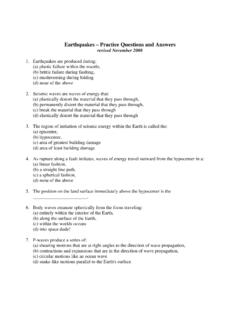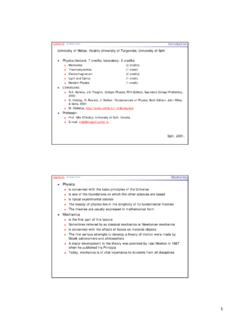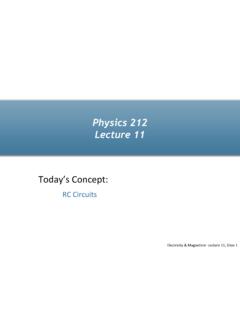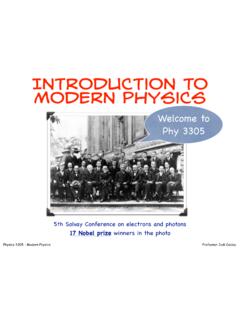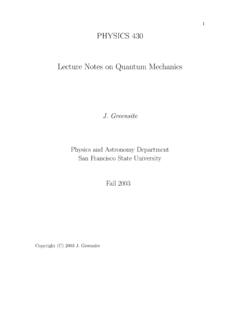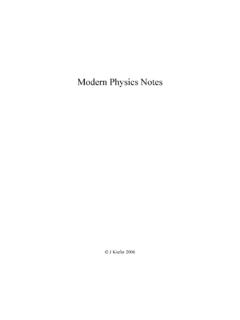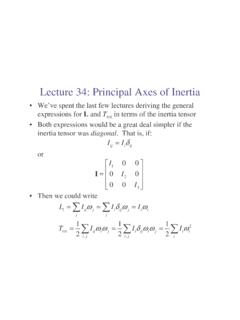Transcription of LECTURE NOTES – PHYSICS 564 NUCLEAR PHYSICS
1 LECTURE NOTES PHYSICS 564 NUCLEAR PHYSICS While this outlines many of the key concepts, it should not replace LECTURE NOTES . Units: Length: 1 angstrom = 10-10 m = 1 1 fermi (or femtometer) = 10-15 m = 1 fm. Energy: 1 electron volt (eV) = energy of electron accelerated through 1 volt electical potential = x 10-19 J. 1 keV = 103 eV; 1 MeV = 106 eV; 1 GeV = 109 eV. 1 u (atomic mass unit, sometimes also ) = MeV (where 12C has mass = ) mp = MeV mn= MeV me = 511 keV !c = MeV-fm. Basic definitions A chemical element denoted by # of electrons = # of protons. Z = # of protons, N = # of neutrons. A=Z+N = mass number.
2 Nuclide = a NUCLEAR species, denotes by Z, N. ( 14C) isotope = same Z, different N. ( 12C, 14C) isotone = same N, different Z ( 12C, 14O) isobar = same A ( 14N, 14C) isomer = same isotope but excited state (usually long-lived) ( 189Au, stable; 189mAu, half-life = 4 minutes) abundance = relative percentage (by number) of a nuclide/isotope. isotopic nomenclature: AX[N] X = chemical species and implicitly denotes Z. Typically 12C although 12C6 is possible to aid bookeeping. (Also possible is AZXN, such as 146C8 again, only for pedantic and bookeeping purposes.) Binding energy and reaction Q-value binding energy is the energy released when a system of particles is bound together, or the energy required to totally dissociated a nucleus into its component protons and neutrons.
3 BE = [ Zmp + Nmn m(N,Z) ]c2; usually in MeV (or in some tables, keV). Mass excess or mass defect : D = (m(N,Z) - A) MeV/u where m(N,Z) is in u and A=N+Z is mass number, so that D is in MeV. packing fraction = -BE/A which related how tightly bound/particle the system is. Is approximately -8 MeV / nucleon for most nuclides. reaction Q-value: In a reaction A B (where A, B can be systems of particles), Q is the energy released , A B+Q. Q can be negative. If Q > 0, reaction is exothermic (releases energy); reaction can proceed without additional energy. If Q < 0, reaction is endothermic and requires energy to proceed. separation energy = energy required to separate a particle or particle, , neutron separation energy Sn = (m(A-1XN-1)+m(n) - m(AXN) )c2 = BE(AXN) -BE(A-1XN-1) PHYSICS 564 p 2 NUCLEAR Radii Assume spherically symmetric distributions r(r) (not necessarily true!)
4 Rms (root-mean-square) radius Rrms ; Systematics: empirically one finds Rrms r0 A1/3, where r0 fm. (This implies approximately constant density and is a consequence of the short-range nature of the NUCLEAR force.) For a sphere of constant density out to radius Rmax, one finds . One must be careful to distinguish between the matter density and the charge density. For a sphere of uniform charge density out to Rmax, the electrostatic or Coulomb energy is . where ke2= MeV-fm. Mirror nuclei are isobars (same A) with opposite numbers of protons and neutrons. For example,14C (Z=6, N=8) and 14O (Z=8, N=6) are mirror nuclei. Scattering Flux = # of particles / unit area / time cross-section has units of area.
5 To get the reaction rate per target particle, multiply flux x cross-section = reactions / time. A standard unit in NUCLEAR PHYSICS is the barn (b) = 10-24cm2 = 100 fm2. One frequently uses the millibarn (mb) = 10-3 b and nanobarn (nb) = 10-9 b. Momentum transfer: for the initial and final momenta ki, kf, of the projectile, the momentum transfer q = ki - kf. In general scattering cross-section sscatt= sRutherford |F(q)|2, where Rutherford scattering is the scattering from a point particle and the form-factor F(q) is a correction due to an extensive particle. (This is true for both total and differential cross-sections.) In its simplest form, the form factor is the Fourier transform of the charge density.
6 For low momentum transfer, F(q) Z(1- 1/6 q2 Rrms2 + ..). ( Actually scattering theory and form factors can be more complicated than this, but for the simplest cases the above are approximately true.) F(q) = Fourier transform of charge density = 2/12rRrms=rdrrdrrRrms3322)()(rr =max53 RRrms=max2253 RZkeEC= =0)()sin(4)(drrqrrqrerdrqirpr!!!! PHYSICS 564 p 3 Quantum theory of angular momentum orbital angular momentum (from relative motion) is quantized in units of : ! L = 0!, 1!, 2!,.. spin (intrinsic angular momentum) can be either integral or half-integral: fermions have half-integral spin s= !, 3/2 !, 5/2!, .. Typical fermions include electrons, protons, neutrons, quarks, bosons have integral spin s = 0!
7 , 1!, 2!, .. (usually drop the !). Typical bosons include pions, photons, W- and Z-bosons, gluons, (gravitons). Components: Classically, angular momentum J has 3 components, J =(Jx, Jy, Jz). In QM we can only discuss the total angular momentum J and one component, usually Jz. (The other components are indeterminant). Jz can take on the values Jz = -J, -J+1, -J+2, .. J-1, J. Sometimes for Jz we write m. So the angular momentum for a particle (or system of particles) is denoted by (J, Jz) or (J,m) Adding angular momentum: The Rules Suppose we start with (J1, m1) and (J2, m2) and add them together. What is final (J, m)? (1) z-component is added: m = m1+ m2.
8 (2) | J1-J2| J J1+J2. The result is in fact a linear superposition of those possible J s, with the probability amplitudes given by Clebsch-Gordon coefficients (which we will ignore as much as possible). Parity Wavefunctions Y such that Y(-r) =Y (r) have even parity; wavefunctions such that Y (-r) = -Y (r) have odd parity. Parity is a multiplicative quantum number and usually denoted by . Electromagnetisim and the strong NUCLEAR force conserve parity, but the weak NUCLEAR force does not conserve parity. For example, neutrinos are left-handed (which means their spins are anti-aligned with their momenta). Quantum statistics of indistinguishable particles A wavefunction of two or more indistinguishable particles ( all electrons or all protons) is either symmetric or antisymmetric under interchange of the particles identities: Y (r1, r2) = + Y (r2, r1) symmetric (for bosons) Y (r1, r2) = - Y (r2, r1) antisymmetric (for fermions).
9 This leads to the Pauli exclusion principle: no two identical fermions can be in exactly the same quantum mechanical state. PHYSICS 564 p 4 Isospin Protons and neutrons have intrinsic spin = , and can have 3rd component sz= . In analogy to this, one can treat protons and neutrons as identical particles, both with isospin = . Total isospin is represented by either T or I. Protons and neutrons have different Tz. I will use protons have Tz = + and neutrons Tz = - (note sometimes you will see it the other way). The coulomb interaction does not conserve isospin since protons have charge +1 and neutron charge 0, but the strong NUCLEAR force does conserve isospin; hence isospin is a good approximate quantum number for nuclei.
10 Radioactive Decay The fundamental decay laws. Let N be the number of radioactive nuclei. dN/dt = -lN or N(t) = N0 exp(-lt). mean life: t = 1/l half-life = time in which half of all nuclei decay away t1/2 = t ln 2 = ln 2 /l . 1 Curie (Ci) = x 1010 decays/s 1 Becquerel (Bq) = 1 decay/s RADIOACTIVE DECAY MODES decay: X A+B+.. reaction: X+Y A+B+.. A decay mode is possible only if the Q-value for the reaction is positive. a particle is stable if no possible decay modes have positive Q-values. branching ratio is the percentage of time a particular decay mode occurs. ALPHA (a) DECAY a-particle is nucleus of 4He. AZXN A-4Z-2XN-2+ a. -governed by tunneling through Coulomb barrier.

